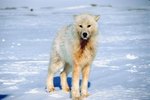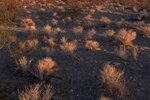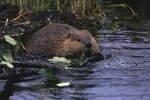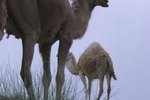The tundra is one of the coldest, harshest habitats on the planet and few animals live year round in these areas. For herbivores, the habitat is made even more harsh by the fact that few plants can survive the conditions. Low shrubs, sedges mosses and lichens are the most common plant species in these conditions, and only a few animals are adapted to survive on this type of vegetation.
Arctic Hare

The Arctic hare is native to the mountainous tundra areas of Canada and Greenland. It is a small mammal that grows to almost two feet in length and up to 11 pounds in weight. It has adapted well to the tundra lifestyle even going so far as growing a white winter coat to blend in with the snow as a protection from predators. The majority of the hare's diet consists of woody plants but it also feeds on mosses and lichens in times of low food availability.
Caribou

The caribou is one of the tundra's largest herbivores. The animal is found throughout the northern Tundra regions globally. It grows to over seven feet in length, up to four feet tall at the shoulder and weighs up to 700 pounds. Seasonally, both sexes of caribou grow large sets of antlers. Caribou feed by grazing on grasses and low lying shrubs. In winter, lichens are an important part of the animal's diet.
Musk Ox

The musk ox is a tundra-dwelling animal that lives throughout the planet's Arctic regions. It grows to over eight feet in length, four feet tall at the shoulder and weighs up to 880 pounds. The ox has a thick body covered in a long, shaggy, insulating coat that is well suited to cold climates. Both sexes possess small, cream-colored curved horns. It is a grazing herbivore, feeding on grasses and shrubs during the summer months. In the winter stems roots, mosses and lichens make up the bulk of the animal's diet.
Lemmings and Voles

Several members of the arvicolinae subfamily live in the world's Arctic tundra regions. They are small rodent species such as the northern bog lemming and snow voles. Some species can grow to over a foot long but many are no longer than a few inches. The animals tend to be herbivores, although some are omnivores. In the cold winters of the tundra lichen is among the few available foods for these small animals along with roots, twigs and tree bark.
References
- University of Michigan Museum of Zoology: Lepus arcticus: Brooke Betzler
- University of Michigan Museum of Zoology: Rangifer tarandus: Nancy Shefferly
- University of Michigan Museum of Zoology: Ovibos moschatus: Sarah Marie Elder
- University of Michigan Museum of Zoology: Arvicolinae: Allison Poor
- Berkeley University: The Tundra Biome
Photo Credits
-
Photos.com/AbleStock.com/Getty Images




